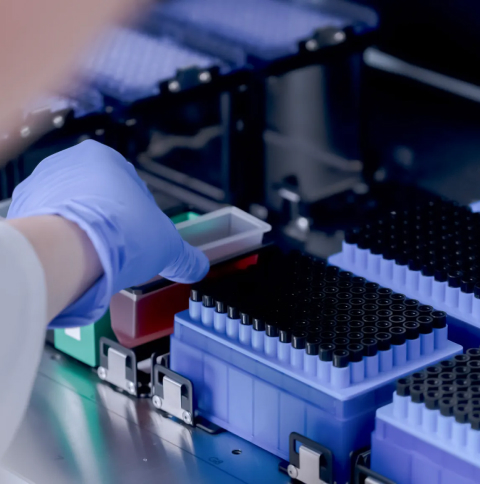

- Method Development
- Method Performance Testing
- Method Transfer
- Specification, Release, Characterization
- Interim Reference Standard
- DS / DP Stability
- Clinical Run
- In-Use Stability/ Product Characterization
- Method Development
- Method Performance Testing
- Method Transfer
- Specification, Release, Characterization
- Interim Reference Standard
- DS / DP Stability
- Clinical Run
- In-Use Stability/ Product Characterization
Leveraging our in-house expertise, we offer a range of analytical services tailored to biologics development. Our qualified release methods adhere to ICH Q2 (R1) guidelines, ensuring reliable and reproducible results.
From characterization to stability testing, Samsung Biologics collaborates with clients to address their analytical needs and accelerate the development of biological therapeutics.
Analytical Method (Release)
-
-
Appearance/
General/Safety - Compendial Testing
-
Appearance/
-
- Quantity
-
Protein Concentration
(A280)
-
- Potency
- ELISA, Cell-based Assay
-
- Identity
- icIEF / Peptide Mapping
-
- Purity/Impurity
-
CE-SDS (R, NR),
SE-HPLC, icIEF / CIEX,
HCP / HCD /
Residual
Protein A, RP-HPLC
Extended Characterization
-
- Primary Structure
-
Intact / Deglycosylated / Reduced MS
Full-length Sequencing
Peptide Mapping (LC-MS)
N/C-terminal Sequencing
-
-
N/O-linked
Oligosaccharides - Glycan site / Structure / Profile
-
N/O-linked
-
-
Aggregation and
Fragmentation - SEC-MALS / DLS
-
Aggregation and
-
- Higher Order Structure
-
Far and Near UV CD / DSC /
Disulfide bond / Free Thiol
-
- Binding Affinity
- SPR (FcRn and FcgRs)
-
- Biological Activity
-
ELISA, Cell-based Assay /
ADCC / CDC
Our team of experts covers diverse cell-based assays based on the MoA of molecules and has established a robust ADCC/CDC assay platform.
We understand how process parameters impact ADCC/CDC effects and efficacy without affecting the development timeline.
-
- ADCC/CDC Assays
-
* Platform methods for target effector:
PD-L1, HER2, EGFR
-
-
Reporter
Gene Assays
-
Reporter
-
-
Cell MoA-based
Proliferation Assays
-
Cell MoA-based
DoE Approach to ADCC/CDC Modulation
N-glycan profiles and relevant antibody effector functions can be successfully evaluated in a time- effective manner alongside process development and clinical material manufacturing using a DoE approach.
Our expert analytical team utilizes a suite of orthogonal methods to provide a detailed analysis of your molecule's structural and physicochemical properties. These techniques can be applied during process development to monitor product quality and for comprehensive product characterization and comparability studies.
-
- Primary Structure
- Fundamental for biologic development, identification, and product homology. Used to confirm the correct protein sequence has been made by verifying the mass of the product by ESI-MS and peptide mapping.
-
- Glycosylation
- Critical to monitor, as the glycan profile can impact biological activity, function, clearance, serum half-life, immunogenicity, and activity.
-
-
Binding Affinity and
Biological Activity - Ensures specificity, activity, and efficacy of the molecule.
-
Binding Affinity and
-
-
Higher Order Structure,
Aggregation, Fragmentation - Changes in higher order structure can impact quality, stability, safety, and efficacy, leading to a loss of biological function and immunogenicity.
-
Higher Order Structure,
Our Analytics Team possesses extensive knowledge and proficiency in conducting stability studies, adhering to relevant ICH
guidelines. Employing a diverse array of state-of-the-art protein analysis techniques, we ensure precision and reliability in your results.
• Our top priority is to ensure our clients’ satisfaction by delivering accurate results promptly.
• By implementing our Electronic Lab Notebook for data digitalization, we leverage an efficient data management system of electronic worksheets and automated data transfer to enforce data integrity.
Non-GMP Stability Testing
We support long-term, accelerated, and stressed stability studies to evaluate the product quality of reference standards, drug substance, and drug product over time under the influence of various environmental factors such as temperature and humidity. These are performed in compliance with ICH Q1A (R2).
In-use Stability
Ensuring the integrity and quality of biotherapeutic products in multidose containers can be challenging. We have the experience and facilities to study the physicochemical attributes and biological activity of drug products in accordance with regulatory guidelines.
To mitigate product development risks, our expert analytical team utilizes state-of-the-art equipment for sequence variant analysis and host cell protein identification, enabling proactive risk monitoring in early stages and risk reduction.
Sequence Variant Analysis (SVA)
SVA is a highly resourceful tool that can potentially de-risk your program by identifying incorrect protein sequences. These sequences could lead to the selection of incorrect multi-specific antibodies and fusion proteins, especially in the case of molecules with common repeating sequences and linkers. State-of-the-art LC-MS/MS used to analyze in-process cell line development and upstream processing samples enables early detection of SVAs, ensuring structural and manufacturing consistency. This process provides further insight into cell line stability.
Host Cell Protein (HCP) Identification
Residual host cell proteins can significantly impact efficacy and cause immunogenicity. Detection and quantification of process-related impurities are required as part of ICH Q6B.
• Proactively monitor and identify HCPs at < 10 ppm.
• Feed information back on specific HCPs to the downstream group to optimize product development.
End-to-End Analytical
Development for Biologics
At our state-of-the-art facility, a team of highly skilled scientists and engineers offers full in-house analytical capabilities. We provide end-to-end solutions for a wide range of biotherapeutics, from monoclonal antibodies to more complex modalities. Recognizing the unique challenges posed by non-mAb molecules, we have developed bespoke analytical methods tailored to your specific requirements. With our unwavering commitment to quality and innovation, we are your trusted partner in navigating analytical development, ensuring the success of your biotherapeutic programs.